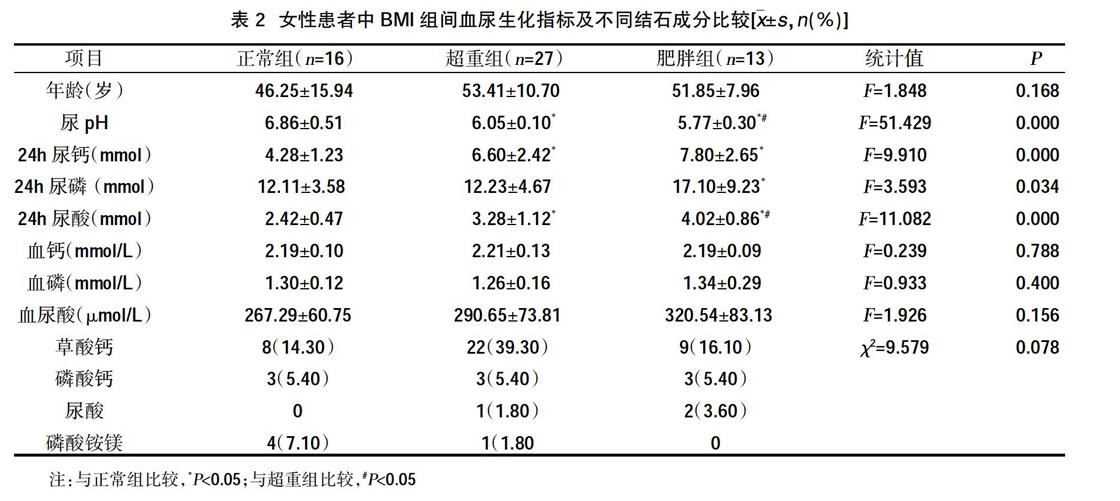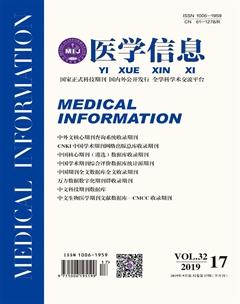尿结石患者体重指数对血尿生化及结石成分的影响
陈友干 向从明 卫冰冰


摘要:目的 分析尿路結石患者体重指数(BMI)对24h尿液、血液生化指标及结石成分的影响。方法 对2017年1月~2018年7月我院收治的尿路结石患者150例进行血尿生化分析,按照BMI分为体重正常组45例、超重组65例,肥胖组40例,检测24h尿钙、磷、尿酸、血钙、血磷、血尿酸及尿pH等指标,同时收集患者结石标本进行红外光谱结石成分分析。比较组间各指标及结石成分的差异性;根据结石成分不同分为四组(草酸钙组、磷酸钙组、尿酸组和磷酸镁铵组),比较组间各指标的差异性。结果 超重组和肥胖组尿液pH均低于正常组(P<0.05);体重正常组患者24h尿钙、尿磷、尿酸和血磷、尿酸明显低于超重或肥胖组(P<0.05)。磷酸镁铵组患者尿液pH高于其它组(P<0.05)。尿酸组和磷酸钙组24h尿磷高于草酸钙组和磷酸镁铵组(P<0.05)。尿酸组24h尿酸高于其它组,磷酸镁铵组24h尿酸低于其它组(P<0.05)。尿酸组血尿酸高于其它组,磷酸镁铵组血尿酸低于磷酸钙组和尿酸组(P<0.05)。磷酸镁铵组BMI低于其它组(P<0.05)。肥胖组、超重组草酸钙、尿酸结石比例均高于正常组(P<0.05),而磷酸镁铵比例则低于正常组(P<0.05)。BMI与尿液pH的相关性分析表明两者高度相关(r=-0.725,P<0.05)。结论 肥胖及超重对血尿生化、血生化、尿pH及结石成分比例有一定影响,且存在性别差异,建议肥胖或超重的尿结石患者行血尿生化、结石成分等评估,注意饮食控制、减重等措施。
关键词:尿路结石;结石成分;血尿生化;BMI
Abstract:Objective To analyze the effect of body mass index (BMI) on urinary calculi in 24h urine, blood biochemical parameters and stone composition.Methods According to the BMI, 150 patients with urinary calculi admitted to our hospital from January 2017 to July 2018 were divided into 45 normal weight group, 65 super-reformed group, 40 obese group, 24 h urinary calcium. Phosphorus, uric acid, blood calcium, blood phosphorus, blood uric acid and urine pH indicators, while collecting patient stone specimens for infrared spectral analysis of stone components. The differences between the indicators and the stone components were compared between the groups; the stones were divided into four groups (calcium oxalate group, calcium phosphate group, uric acid group and magnesium ammonium phosphate group), and the differences among the indicators were compared.Results The urine pH of the super-recombinant and obese group were lower than the normal group, the difference was statistically significant (P<0.05). The 24 h urinary calcium, urinary phosphorus, uric acid, blood phosphorus and uric acid were significantly lower in the normal weight group than in the overweight or obese group(P<0.05). The urine pH of the patients in the ammonium magnesium phosphate group was higher than that in the other groups(P<0.05). The urinary phosphorus in the uric acid group and the calcium phosphate group 24 h was higher than that in the calcium oxalate group and the ammonium magnesium phosphate group(P<0.05). The uric acid group was higher than the other groups in 24 h, and the uric acid in the ammonium magnesium phosphate group 24 h was lower than the other groups(P<0.05). The uric acid group had higher blood uric acid than the other groups. The calcium urate group was lower than the calcium phosphate group and the uric acid group(P<0.05). The BMI of the ammonium magnesium phosphate group was lower than that of the other groups(P<0.05). The proportion of obese group, super recombinant calcium oxalate and uric acid stone was higher than normal group (P<0.05), while the proportion of magnesium ammonium phosphate was lower than that of the normal group(P<0.05). Correlation analysis between BMI and urine pH showed that the two were highly correlated (r=-0.725, P<0.05).Conclusion Obesity and overweight have certain effects on hematuria biochemistry, blood biochemistry, urine pH and stone composition ratio, and there are gender differences. It is recommended that patients with obesity or overweight urinary stones should be evaluated for hematuria biochemistry and stone composition, pay attention to measures such as diet control, weight loss and other measures.
Key words:Urinary calculi;Stone composition;Hematuria biochemistry;BMI
尿结石(urinary stone)是泌尿系最常见的疾病,我国的尿结石患病率约为1/17[1],其成因较多,但具体机制尚不清楚。近年来,有研究认为肥胖是结石病的高危因素,且体重指数(BMI)的高低与尿液成分的改变有一定相关性[2]。目前国内鲜有BMI与血、尿生化指标同时结合结石成分关系的研究报道,本研究通过收集并分析150例结石患者BMI、24h尿生化、血生化及结石成分等指标,探讨BMI对血尿生化及结石成分的影响,为尿结石的预防和治疗提供参考。
1资料与方法
1.1 一般资料 选取2017年1月~2018年7月江南大学附属医院泌尿外科收治尿路结石患者150例,按照BMI分为体重正常组45例、超重组65例,肥胖组40例。患者均经影像学确诊(如B超、KUB平片或CT),合并有肿瘤、甲状旁腺功能亢进患者予以排除,检测前停用可能影响分析结果的药物,如钙制剂、利尿剂等。根据WHO对亚洲人群肥胖程度的评价标准分为:正常(18.5 kg/m2≤BMI<24 kg/m2)、超重(24 kg/m2≤BMI<27 kg/m2)和肥胖(27 kg/m2≤BMI),体重指数(BMI)=体重/身高2 (kg/m2);根据尿结石的成分不同将患者分为四组:草酸钙组、磷酸钙组、尿酸组和磷酸镁铵组。
1.2资料及标本收集 留取当日晨7点至次日晨7点的尿液,每次收集后冰箱4°C保存,24h总尿量由同一名护士准确记录,总尿液混匀后取10 ml与抽取的空腹血2 h内送检。美国贝克曼库尔特公司(Bechman Coulter,Inc)仪器检测24h尿生化、血生化检测采用。尿pH采用尿液自动分析仪检测。患者评估期间的身高、体重由同一名护士精确测量并记录。
1.3 尿结石成分分析 结石成分分析采用结石红外光谱自动分析系统(天津蓝莫德科学仪器有限公司)。结石用清水洗净,70~100℃烘箱内烘干。取适量结石粉末(1 mg)与已干燥的纯溴化钾(200 mg)混合均匀,在玛瑙乳钵内研碎至粉末,该混合物烘焙10~30 min后压片机加压,将其制成半透明片,并放入人红外光谱槽中进行扫描。电脑绘制谱图后自动解析和报告结石成分。
1.4 统计学方法 采用SPSS 21.0统计软件进行分析,计量资料以(x±s)表示,组间比较采用Student's t检验,两组以上的差异比较采用one-way ANOVA;采用Pearson相关性分析,计数资料使用(%)表示,采用?字2检验。P<0.05表示差异有统计学意义。
2结果
2.1患者一般资料 本组患者共150例,男94例(62.67%),女56例(37.33%),其中体重正常45例(30.00%),超重65例(43.33%),肥胖40例(26.67%),男女比例1.67∶1,平均年龄(50.65±13.85)岁;平均BMI(25.08±3.02)kg/m2;草酸钙、磷酸钙、尿酸和磷酸铵镁结石比例分别为73.33%、15.33%、6.67%和4.67%。本组病例中合并有高血压病患者38例,糖尿病22例,组间比较,差异无统计学意义(P>0.05)。
2.2结石患者的24h尿液生化、血生化及结石成分比较 150例结石患者中不同结石成分比例,肥胖组32例(71.10%)、超重组53例(81.50%)的草酸钙比例高于与正常组的25例(62.50%)(P<0.05);肥胖组6例(15.00%)、超重组3例(4.60%)的尿酸比例高于正常組的1例(2.20%)(P<0.05);肥胖组0、超重组2例(3.10%)的磷酸镁铵比例低于正常组5例(11.10%),差异有统计学意义(P<0.05);超重组7例(10.80%)、肥胖组9例(22.50%)的磷酸钙比例与正常组7例(15.60%)比较,差异无统计学意义(P>0.05)。按性别分层后,男性患者肥胖组尿液pH低于正常组(P<0.05);正常组24h尿钙、24h尿磷和24h尿酸低于超重和肥胖组(P<0.05);超重组和肥胖组的血磷均高于正常组,且肥胖组血磷高于超重组(P<0.05);超重组和肥胖组的血尿酸高于正常组(P<0.05)。女性患者正常组尿液pH高于超重组和肥胖组(P<0.05);超重和肥胖组24h尿钙、尿酸高于正常组,肥胖组24h尿酸高于超重组和正常组(P<0.05),见表1、表2。
2.3按结石成分分层后24h尿液生化、血生化等指标比较 磷酸镁铵组患者尿液pH高于其它组别,磷酸钙组的尿液pH低于草酸钙组和磷酸镁铵组(P<0.05)。尿酸组和磷酸钙组24h尿磷高于草酸钙组和磷酸镁铵组(P<0.05)。尿酸组24h尿酸高于其它组别,磷酸镁铵组24h尿酸低于其它组别(P<0.05)。尿酸组血尿酸高于其它组别,磷酸镁铵组血尿酸低于磷酸钙组和尿酸组(P<0.05)。磷酸镁铵组BMI低于其它组别(P<0.05)。
2.4 BMI和尿液pH的相关性分析 经Pearson相关分析,结果显示BMI和尿液pH高度相关(r=-0.725,P<0.05)。
3讨论
泌尿系结石是全世界历史悠久且普遍的疾病,结石病的成因可能与性别、饮食习惯、区域差异及代谢异常等相关。国外研究表明BMI的升高是泌尿系结石的危险因素之一[5],国内尚缺乏这方面的研究。本研究检测了患者血尿生化指标,并结合结石成分进行相关分析。BMI对尿液成分的影响有一定性别差异性[3,4]。糖尿病、高血压病是结石的危险因素[5],本研究患者合并高血压病38例,糖尿病22例,组间其分布比例差异无统计学意义(P>0.05),可以认为高血压、糖尿病在组间分布均匀。研究显示当BMI升高时患者pH随之降低,性尿钠、钙、尿酸、镁及草酸等相应产生变化[4]。

